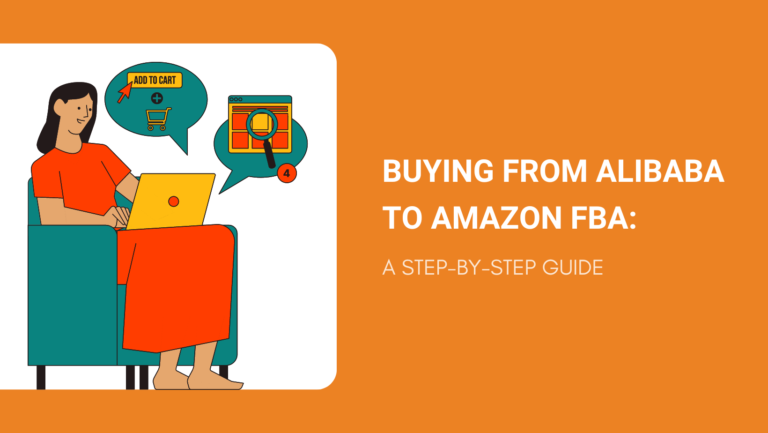Are you an aspiring entrepreneur looking to tap into the world of eCommerce? Leveraging Alibaba to source products for Amazon FBA could be your next big move.
With a massive range of products and cost-saving benefits, Alibaba is a powerhouse for finding goods to sell on Amazon’s streamlined platform.
This article will serve as a comprehensive guide to help you navigate the process of buying from Alibaba and selling on Amazon FBA.
You’ll learn how to find reliable suppliers, avoid common pitfalls, and maximize your profits through efficient logistics and smart sourcing strategies. By the end, you’ll be well-equipped to confidently start your eCommerce journey.
What Is Alibaba?
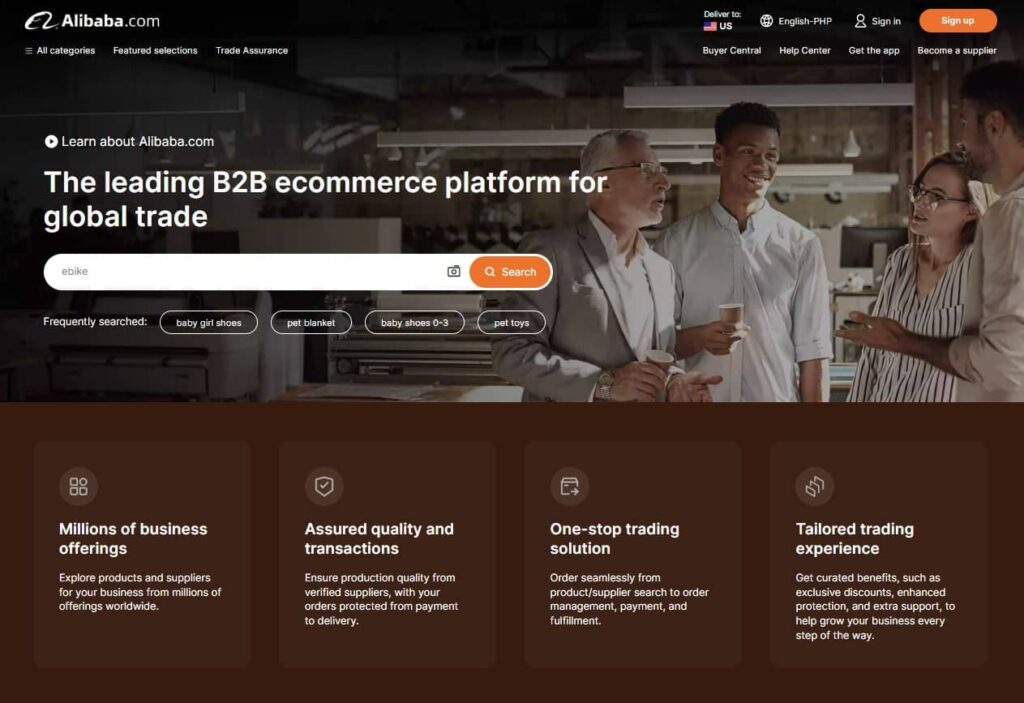
Alibaba is a leading global e-commerce platform designed for wholesale trade. It connects buyers worldwide with suppliers, predominantly from China.
This marketplace is ideal for businesses looking to purchase products in bulk at competitive prices.
Founded in 1999 by Jack Ma in Hangzhou, China, Alibaba has grown significantly over the years. It now stands as a pillar in global trade, supporting millions of businesses.
Key Features of Alibaba
- Supplier Directories: Easily browse and compare suppliers. Each supplier’s profile includes ratings and reviews from previous buyers.
- Trade Assurance: This feature ensures order protection. If your products are not shipped on time or do not meet quality standards, you get a refund.
- Product Categories: Alibaba offers a vast range of categories, from electronics to fashion. The platform hosts millions of products, ensuring you find exactly what you need.
- Global Reach: You can connect with suppliers from various countries, expanding your market reach.
- Customization Options: Many suppliers offer customization, allowing you to brand products according to your needs.
What Is Amazon FBA?
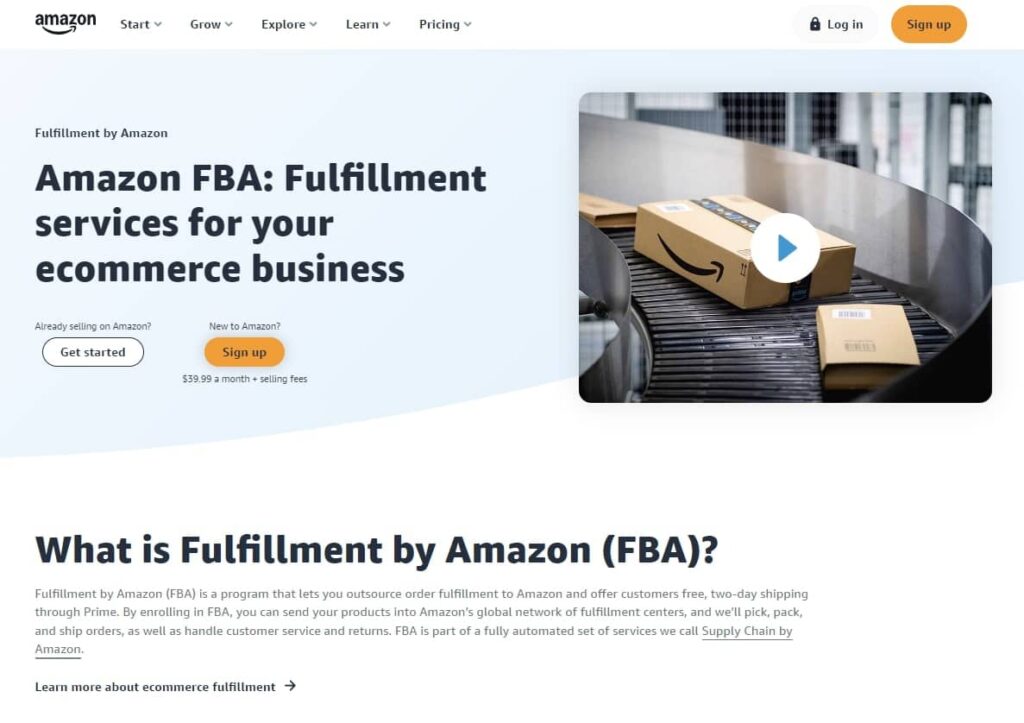
Amazon FBA, short for Fulfillment by Amazon, is a service that enables sellers to store their products in Amazon’s fulfillment centers. When a customer places an order, Amazon takes care of the picking, packing, and shipping.
Amazon FBA was introduced in 2006. Since its launch, it has evolved to include additional features such as returns management and customer service.
Key Features of Amazon FBA
- Storage: Your products are stored in Amazon’s vast network of fulfillment centers.
- Packaging: Amazon handles the packaging, ensuring products are safely shipped.
- Shipping: Amazon manages the shipping process, often offering fast delivery options like Prime shipping.
- Customer Service: Amazon provides 24/7 customer service, handling inquiries and returns for you.
The Connection Between Alibaba and Amazon FBA
By now, you must have already understood the connection between Alibaba and Amazon FBA. The sellers on FBA source products from Alibaba and sell on Amazon.
Most suppliers on Amazon do not have their products. They source products from one place and sell them on Amazon. That’s why they are known as retailers.
In this case, the suppliers on Amazon FBA source products from Alibaba. They have two options.
- Buy from Alibaba and send them to Amazon.
- Ask Alibaba suppliers to send the products directly to Amazon.
In both cases, the FBA sellers are buying the products from Alibaba in advance and sending them to Amazon warehouses before they have the orders for those products.
So, the Amazon FBA is a different model than Amazon Dropshipping.
The Pros and Cons of Buying from Alibaba to Sell on Amazon FBA
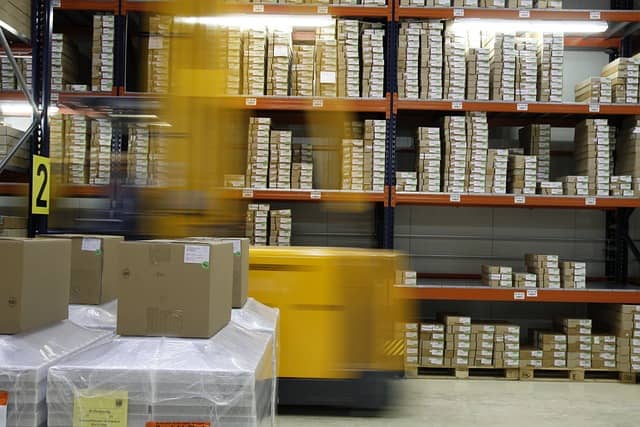
Pros
Vast Selection of Products
On Alibaba, you have access to a wide range of products at competitive prices. This gives you the flexibility to find the best products to buy on Alibaba and sell on Amazon.
High Profit Margins
If done correctly, buying from Alibaba and selling on Amazon can be profitable. Many sellers achieve significant margins by sourcing products at low costs and selling them at higher prices on Amazon.
Opportunities for Private Labeling
You can create your own brand by private labeling products. This allows you to differentiate your offerings and build customer loyalty.
Cons
Unreliable Suppliers
Dealing with unreliable suppliers can be a risk. Some suppliers may not meet their promises, leading to issues with product quality or delayed shipments. Proper vetting is essential.
Quality Control Challenges
Ensuring product quality can be difficult when sourcing from overseas. You might need to hire third-party inspection services, which can add to your expenses.
Import Duties and Shipping Costs
Shipping costs and import duties can significantly impact your profit margins. Air freight is quick but expensive, whereas sea freight is cheaper but slower. Understanding these costs is crucial.
Minimum Order Quantity
Many suppliers on Alibaba require a minimum order quantity (MOQ), which might be more than you need initially. This can lead to higher upfront costs.
Shipping Costs
Shipping costs can vary depending on the method and the distance. Air freight is quicker but more costly for smaller shipments, while sea freight is economical but slower.
Factoring in these costs is essential for maintaining profitability. When shipping to Amazon FBA centers, it’s helpful to arrange shipping through your supplier, especially for small shipments.
Setting Up Your Alibaba and Amazon Accounts
Creating accounts on Alibaba and Amazon is the first step to start selling. It involves setting up professional profiles, verifying accounts, and familiarizing yourself with key features.
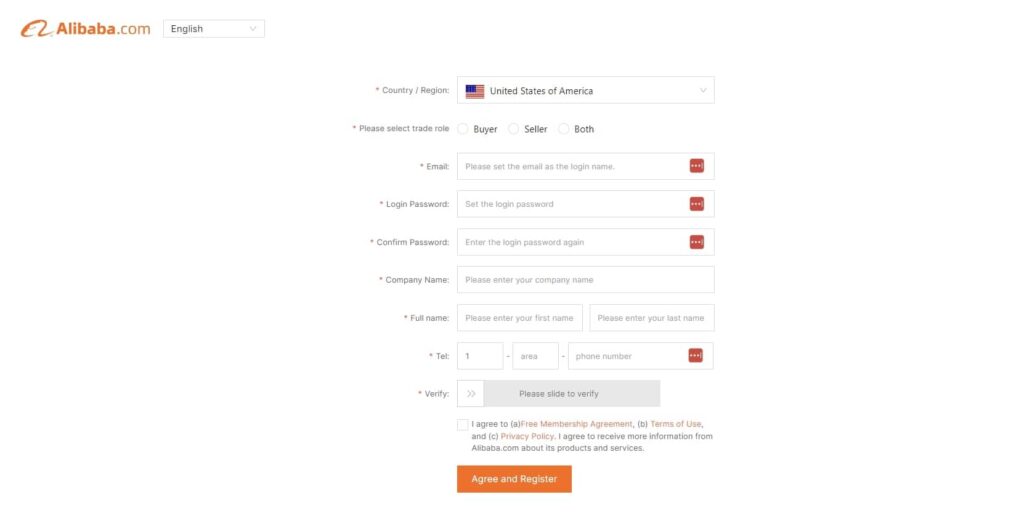
Alibaba
- Create an Account: Visit the Alibaba registration page and click on “Join Free”. Enter your email address, and create a password.
- Verify Account: Alibaba will send a verification email. Click on the link provided to verify your email. This step is crucial to access full features and ensure trust.
- Complete Profile: Fill out your profile with accurate business information. Add details like company name, contact details, and business license.
- Navigate the Platform: Familiarize yourself with Alibaba’s interface. Use the search bar to find products and explore categories.
- Tip: Utilize Alibaba’s Trade Assurance to protect your orders and ensure payment security.
- Finding Suppliers: Use filters to narrow down suppliers. Always check ratings and reviews. Use the “Contact Supplier” button to communicate directly for quotes and negotiations.
Amazon Seller Account
- Create an Account: Go to the Amazon Seller Central homepage and click “Register Now”. Choose between an Individual or Professional account based on your sales estimates.
- Set Up Account: Fill in your details, including your business email, company name, and address. Provide additional business information required.
- Choose Seller Plan: Decide on the appropriate plan:
- Individual Plan: Suitable if selling fewer than 40 items per month.
- Professional Plan: Best for higher volume sellers, includes advanced features.
- Set Up Payments: Enter your bank account details for payments. Ensure you have all necessary documents like ID and business information for verification.
- Optimize for FBA: Once your account is set up, navigate to “Fulfillment by Amazon” to integrate FBA services.
- Tip: Ensure compliance with all of Amazon’s policies. Proper setup can prevent account suspension and maintain smooth operations.
Alibaba to Amazon FBA: Step-by-Step Guide
Follow the step-by-step guide mentioned below and you will be good to go with Alibaba shipping directly to Amazon.
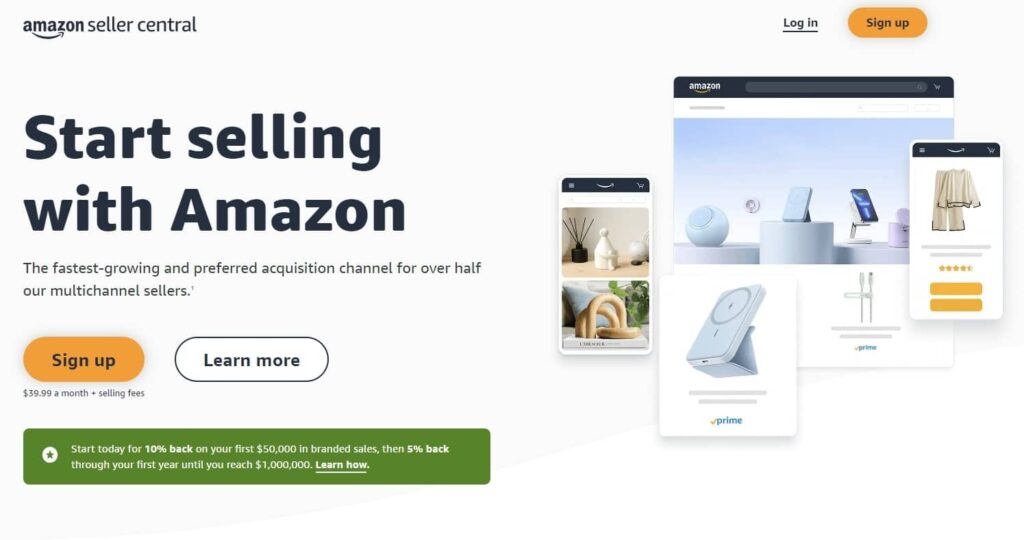
- Open your Amazon Seller Central page and click “Manage Inventory”. Your product should have an “active” status in this section.
- Click the “edit” menu on the right-hand side of the page on your Amazon seller central.
- From the drop-down menu that opens up by clicking “edit”, click “Send/Replenish Inventory”.
- It will take you to another screen that asks you for the “Ship from” address and the “Packing type”. In this case, the “Ship from” address will be your supplier’s address, not yours. That’s because you are asking an Alibaba supplier to ship directly to an Amazon warehouse.
- The next screen will ask you for the info like name, address, country of origin, etc. Fill this information as per the supplier’s information mentioned on his Alibaba page. (Tip: You can also contact the supplier and ask him what info should you give here.)
- Next, you have to confirm the packing type. Choose “Individual products” if you would be selling individual items with SKUs or different items in one box. If there are no SKUs or variants, you should choose “Case-packed products”.
- The next screen will ask you some questions regarding the details of the products. You also have to provide info like “Units per case” and “Number of cases”.
- The next page asks you about “who preps”. You have two options to select here. One is “Amazon” and the other is “Merchant”. (Tip: Most suppliers on Alibaba know how to prepare products according to Amazon guidelines. You should confirm this from your supplier and choose the options accordingly. If you choose “Amazon” in the “Who preps” option, you would have to pay for this service.)
- After that, you must fill in the information about labeling your products. This includes the FNSKU (Fulfillment Network Stock Keeping Unit) labeling. It is a barcode that helps Amazon scan it to know the details of the products. (Tip: Here also, you have the option to tell your supplier to label your products (Recommended) or have Amazon do it for you (Paid service). In the first case, you have to send FNSKU labels to your supplier that Amazon provides you in this section.)
- The next step is to view shipments. Here, you have information regarding the relevant Amazon fulfillment center where you would have to get your products delivered. For example, it will be the Amazon fulfillment center in a particular city in the USA where your supplier will ship from China. Depending on the scale of your Amazon business, it may have more than one fulfillment center.
- The next section is preparing the shipments. You have to fill in the info regarding your shipment methods, etc. In the case of Alibaba, the shipment method can only be by air or ocean. You must also tell Amazon about carriers like DHL, FedEx, etc. Ask your supplier whether he will use FCL or LCL and fill in the info accordingly.
- The next sections include the shipment packaging. You have to mention if everything will be in one box or if there will be multiple boxes. Fill in the box weight and dimensions after confirming it from your supplier.
- In the last step, you would have to tell Amazon about the type of paper your supplier would use as a shipping label. You must choose from plain paper, a blank rectangle label, or a thermal printing label.
In the same section, you also need to tell Amazon about the tentative shipment arrival date. After that, you will get the automatic print labels in soft forms. Save and send them to your supplier so that he can use them on shipping labels.
You finish this process when you click the “Complete shipment” button.
All of these steps are systematic enough to facilitate Amazon and your supplier’s smooth completion of the whole supply chain process.
When Amazon receives your package, it knows exactly what is in it and where to place it for further use.
Amazon FBA Preparation Requirements
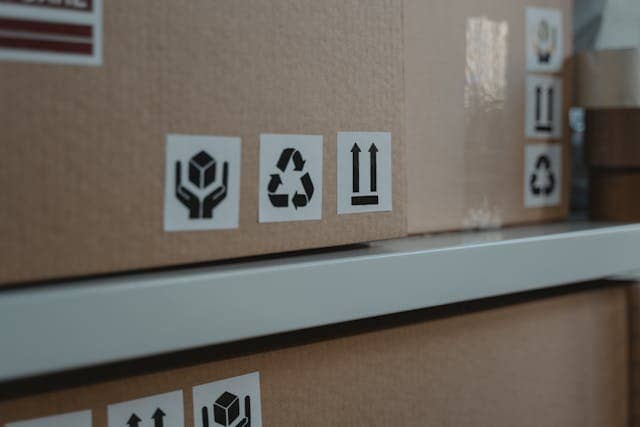
Follow Amazon’s labeling and packaging guidelines meticulously. Products must meet Amazon’s standards to be accepted at their fulfillment centers. This includes FNSKU labeling, product packaging, and bundling as required:
- The products are correctly labeled showing options like “sold as the sets”, case labels, pallet labels, etc.
- Products are correctly packaged. Examples include boxes, polybags, shrink or bubble wrapping, blister, case packaging, etc.
- Other prep requirements include the guidelines for product weight and sizes, etc.
All of these instructions are mentioned on the Amazon website to facilitate sellers.
How to Find Reliable Suppliers on Alibaba?
Ensuring you find a reliable supplier on Alibaba is crucial for the success of your eCommerce business.
Verification Methods
Alibaba offers several verification badges to help you identify reputable suppliers. Look for:
- Gold Supplier: Paid members verified by Alibaba.
- Verified Supplier: These suppliers have passed an on-site check by a third party.
- Trade Assurance: Offers payment protection ensuring you get your products as specified.
Due Diligence
Conduct thorough due diligence:
- Check Business Licenses: Ask suppliers to provide their business license to verify legitimacy.
- Factory Visits: Arrange a visit to the supplier’s factory, or hire a third-party inspection service.
- Request References: Ask for references from other buyers who have previously worked with the supplier.
Communication
Effective communication is key:
- Contact Supplier: Initiate contact through Alibaba’s messaging system for record keeping.
- Detailed Inquiries: Be clear about your product specifications, quality standards, and other requirements.
- Regular Updates: Maintain regular communication to stay updated on production progress.
Things to Know before Buying on Alibaba and Selling on Amazon
Minimum Order Quantity (MOQ)
When purchasing from Alibaba, suppliers often set a minimum order quantity (MOQ). This means you must buy a certain number of units per order.
MOQs can vary; some suppliers have MOQs as low as 50 units, while others require 1,000 units. Always check the MOQ before making commitments.
Shipping Costs

Shipping costs can significantly affect your profit margins. Air freight is faster but more expensive than sea freight.
For small orders, air freight might be more practical. For larger shipments, sea freight is more cost-effective.
Use tools to estimate your shipping costs.
Quality Control
Ensuring product quality is critical for maintaining customer satisfaction. Opt for pre-shipment inspections and sample orders to verify quality. You can hire third-party inspection services to perform checks at the supplier’s warehouse.
This step helps you identify any defects or issues before the products reach Amazon FBA centers.
Compliance and Regulations
Before importing products, you must comply with U.S. import regulations and Amazon’s seller guidelines. This includes meeting safety standards and labeling requirements.
Visit the U.S. Customs and Border Protection website for detailed information on import regulations.
Costs and Fees
When calculating your costs, include the following:
- Product costs: The price per unit multiplied by the quantity.
- Shipping costs: Fees for air or sea freight.
- Duties and taxes: Import fees based on your product category.
- Amazon fees: Fulfillment and storage fees for using Amazon FBA.
Risk Management
Minimize risks by diversifying your suppliers. Having at least two suppliers can protect you against delays or quality issues from any single supplier.
Additionally, consider purchasing business insurance to cover potential losses from shipping damages or other unforeseen problems.
These are some of the crucial factors you need to account for before diving into the business of buying from Alibaba and selling on Amazon.

Frequently Asked Questions
When considering the journey from Alibaba to Amazon FBA, many sellers have common queries about profitability, product selection, costs, and making payments to suppliers.
Is Buying from Alibaba and Selling on Amazon Profitable?
Selling products sourced from Alibaba on Amazon FBA can be profitable.
Key factors influencing profitability include product selection, cost of goods, shipping costs, and competitive pricing on Amazon.
Successful sellers often invest time in thorough market research and leverage tools like Jungle Scout to identify profitable niches.
What Are the Best Products to Buy on Alibaba and Sell on Amazon?
Popular product categories include electronics, home goods, and fashion accessories. Tools like Helium 10 and market research trends can help you spot high-demand items.
Products that are lightweight, durable, and have a high perceived value tend to perform well on Amazon.
What Costs Are Involved in Selling on Amazon FBA?
The costs involved in selling on Amazon FBA are briefly listed below.
- The selling plan on Amazon. It is either $0.99 for each unit sold (Individual plan) or $39.99 per month with no deduction on each unit sold (Professional plan).
- Referral fees deducted by Amazon range from 8% to 15% of the product price depending upon the type of the products.
- FBA fees depend on the products. The details of the FBA fees are mentioned on the Amazon FBA page.
- The Amazon FBA storage fee ranges from $0.83 to $3.63 per cubic foot depending upon the type of products (dangerous or non-dangerous goods) and the peak or non-peak season.
- Advertising fee if applicable.
How to Pay Alibaba Suppliers?
Alibaba facilitates a lot in making Alibaba payments. It supports multiple payment channels giving the customers an edge to choose a payment method that suits them best.
Depending upon certain Alibaba’s terms and conditions, the following payment methods can be used with Alibaba.
- Alibaba Escrow Payment (Alipay)
- Credit Card
- Western Union
- QIWI
- Web Money
- Yandex
- Telegraphic Transfer
- PayPal
- Wire Transfer
- Online Bank Payment
- Apple Pay
- Boleto
- L/C
- D/P
Wrapping Up: Key Takeaways for Success with Alibaba to Amazon FBA
Understanding the basics of how Alibaba and Amazon FBA work is essential for success. Alibaba offers a vast marketplace where you can source products, while Amazon FBA handles warehousing, packing, and shipping your products directly to customers.
That’s why efficient freight forwarding is a game-changer in when shipping your products from Alibaba to Amazon FBA. This can save you a lot of hassle and ensure your products arrive on time and in good condition.
If you need help sourcing products or shipping from China, our freight forwarding services can simplify the process and ensure your products reach Amazon FBA efficiently.
Request a quick quote from NicheSources for personalized assistance and take the first step towards a successful Alibaba to Amazon FBA business.
